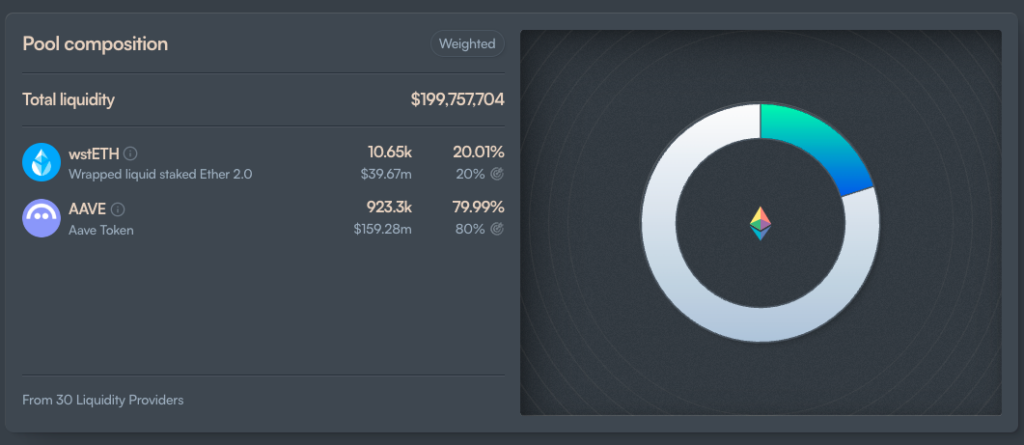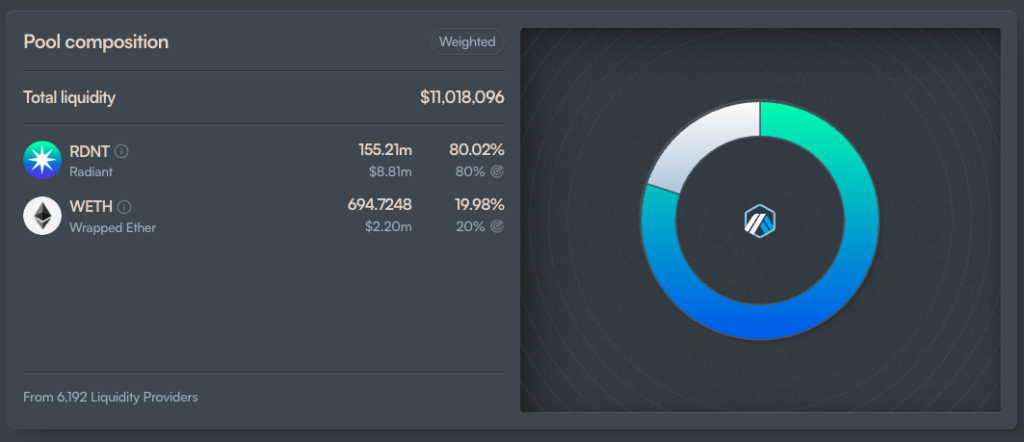Governance tokenomics has always been a challenge, and even the major protocols are still wrestling with it. Struggling to effectively balance incentives, liquidity and governance power.
Who hasn’t heard the golden question: where does the yield actually come from?
While many solutions are still in the works, one promising approach to addressing this issue is the 80/20 liquidity pool model. Let’s take a closer look at how this model works and why it could be a game changer for protocol-native token utilization.
What’s an 80/20 pool?
An 80/20 pool, powered by Balancer’s weighted math, is a type of liquidity pool where assets are split in an 80/20 ratio. Here, 80% of the pool is typically the protocol’s native token (e.g. Aave) and the remaining 20% is a highly liquid token such as ETH, USDC or DAI. Unlike traditional 50/50 pools, this approach allows protocols to maintain high exposure to their own tokens while still allowing active trading and governance participation.
Balancer’s weighted pools allow for up to 8 tokens in a single pool with any custom ratio, unlocking the potential for protocols to create unique liquidity structures that suit their needs – whether for governance, liquidity incentives or price stability.
Why 80/20 pools can be a game changer?
Governance tokens are essential for decentralised decision making, but “traditional” unilateral staking models often create liquidity problems. When large amounts of governance tokens are tied up in staking, less liquidity is available in active trading markets. This can lead to higher price volatility, increased slippage and difficulties for traders trying to make larger trades.
By adopting the 80/20 pool model for governance tokens, the protocols address these liquidity challenges head-on. Instead of staking individual tokens, users stake liquidity pool tokens – Balancer Pool Tokens (BPTs) – which they acquire by providing liquidity to the 80/20 pool. This way, stakers retain their governance power, but because they’re staking a liquidity pool token, the underlying assets remain active in the market. This model completely reverses the typical liquidity problem: the more users stake, the deeper the pool’s liquidity becomes.
Benefits of 80/20
- Deep liquidity for governance tokens: As mentioned above, when governance is tied to an 80/20 pool, the staked liquidity remains active and tradable. This leads to lower slippage and price volatility, making the token more stable and attractive to investors.
- More efficient incentive programs: Traditional incentive models often spread rewards across multiple pools and DEXs, fragmenting liquidity and increasing costs. In contrast, the 80/20 model concentrates liquidity in a primary pool, simplifying incentives and reducing costs. As a bonus, swap fees from the pool can serve as an additional incentive for liquidity providers, making the pool more attractive
- Asymmetric upside and hedging: The 80% allocation in the protocol token allows for what’s known as asymmetric upside. As the protocol’s token appreciates, LPs benefit more than they would with a 50/50 pool (which is why we avoid a 50/50 model for governance), while the 20% in a base asset provides some stability as a hedge. This design is particularly beneficial in volatile markets where LPs want upside potential with reduced downside risk.
- Reduced impermanent loss: With an 80/20 split, LPs experience less volatility loss than with a traditional 50/50 pool. This setup gives them high exposure to the protocol’s token (80%) while limiting exposure to price fluctuations in the smaller, base token portion (20%). The result is a model that balances both token exposure and volatile loss mitigation.

The chart above illustrates impermanent loss for different Balancer two-token pool weights. With a 5x price change, a 50/50 pool will see about 25% impermanent loss, while an 80/20 pool will reduce that to around 14%, and a 95/5 pool will further reduce it to just under 4%.
We’ll save a deeper dive into the math behind these weighted pools for a future article.
Real world examples
The approach has gained popularity. Major protocols such as Aave, Radiant Capital, Alchemix, Paraswap and most recently Mode Network have all implemented the 80/20 model with great results.
Aave: Through its 80/20 pool, Aave has created a robust liquidity buffer for its security module, maintaining significant exposure to ETH while ensuring governance stability. This setup provides a flexible but resilient foundation for Aave’s governance. This pool currently holds nearly $200 million TVL.

Radiant Capital: Radiant’s use of the 80/20 model generated nearly $750,000 in swap fees in just the first month, underscoring the model’s ability to create additional revenue streams while keeping liquidity readily available to users. Now over $11M in TVL.

Alchemix & Paraswap: Both protocols have integrated 80/20 pools, with both TVLs around $7M.
Mode Network: Mode Network has taken the 80/20 model a step further by integrating it directly into its governance tokenomics in collaboration with Aragon. Here’s how Mode’s integration works:
- An 80/20 $MODE | $ETH BPT (Balancer Pool Token) is embedded within the governance model, allowing users to stake the BPT to obtain veMODE, which unlocks voting power.
- Voters can direct $OP incentives to specific protocols within the Mode network, incentivizing ecosystem growth.
- Stakers earn $OP rewards for voting, aligning governance power with liquidity and protocol rewards.
Why 80/20 pools are shaping DeFi governance
As more DeFi projects explore 80/20 liquidity pools, we’re seeing a thoughtful approach to balancing liquidity needs with governance efficiency. By addressing core liquidity challenges while preserving governance power, the 80/20 model provides a compelling framework for protocols to manage and maintain their native tokens.
It’s encouraging to see different approaches to tokenomics, especially for critical aspects like governance and liquidity. The 80/20 model may not be a one-size-fits-all solution, but it represents an innovative step in evolving DeFi governance for the better.



